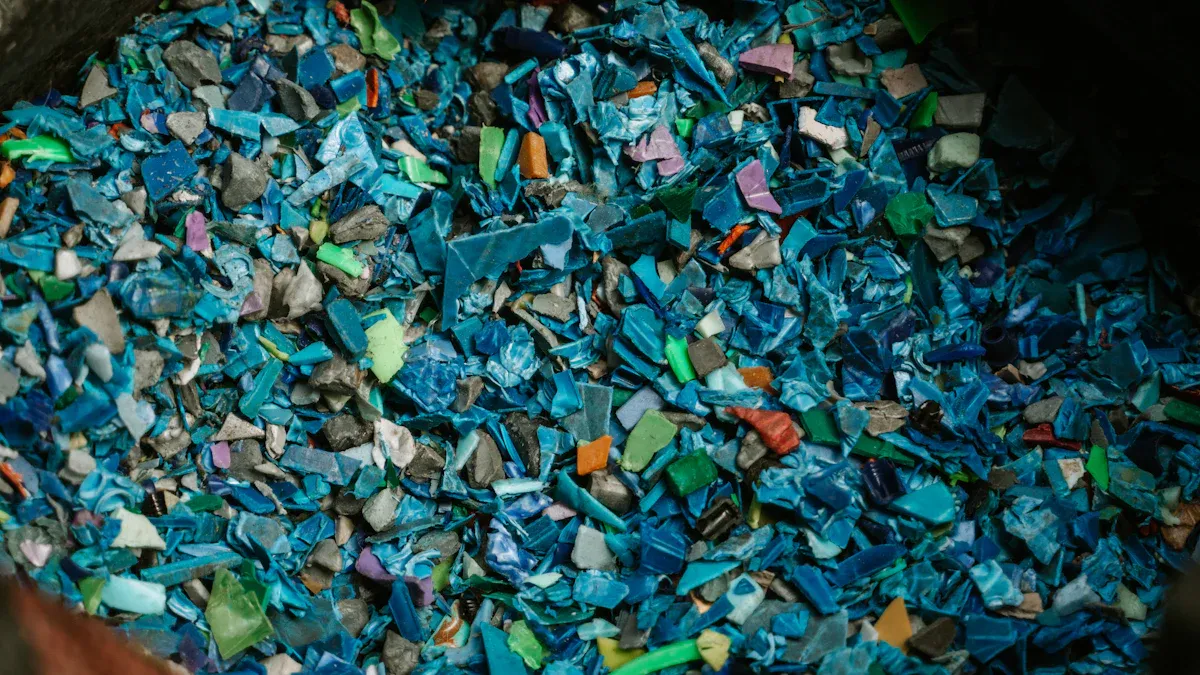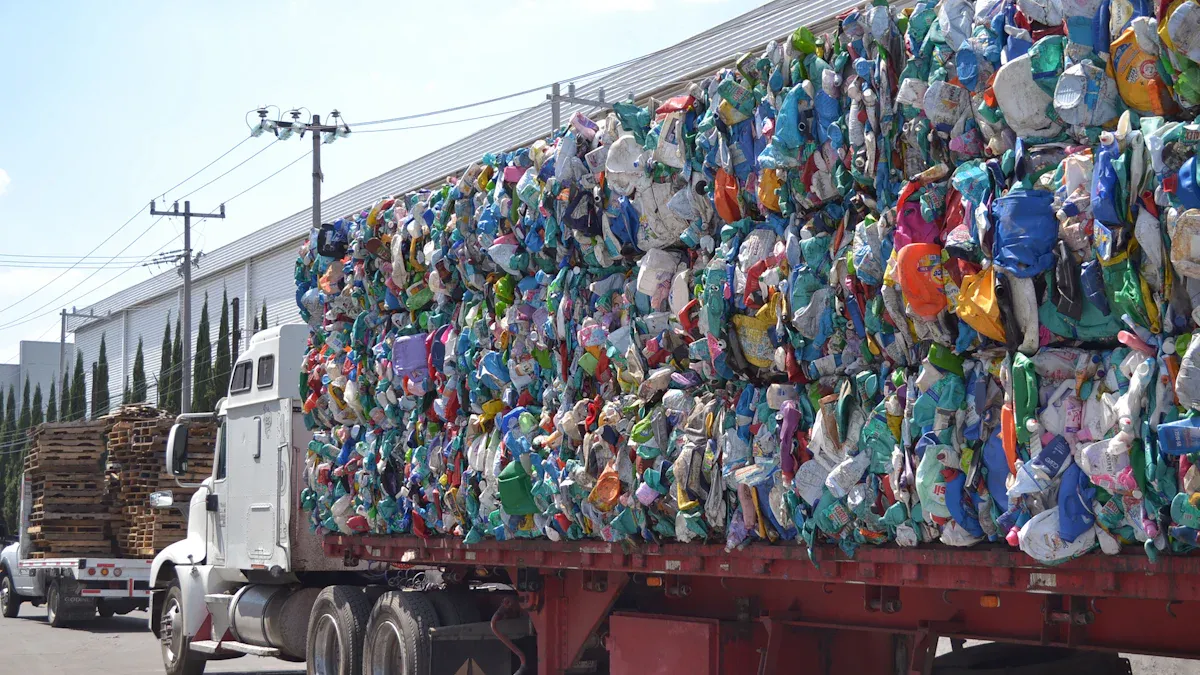Supply Chain in the Circular Economy: From Linear to Closed-Loop

The global demand for sustainable practices has made the shift from linear to closed-loop supply chains more critical than ever. This transition minimizes waste by reusing resources, aligning with the principles of the circular economy. Companies adopting these practices often achieve significant benefits. For instance, 74% of supply chain leaders predict profit growth by 2025 through circular economy strategies. Examples like Adidas using ocean plastic in manufacturing and Patagonia extending product life cycles underscore the practicality of this approach.
JUSDA plays a transformative role in this evolution. By offering intelligent solutions, it enables industries to adopt circular practices seamlessly, fostering both sustainability and efficiency.
Key Takeaways
Moving to circular supply chains cuts waste and helps the planet. It also boosts business profits.
Make products last longer, easy to fix, and recyclable. This reduces trash and keeps them useful longer.
Use smart tools like IoT and AI to track items better and make returning goods easier.
Work together with companies, suppliers, and others to build systems that reuse resources well.
Solve problems like high costs and tricky rules to make circular supply chains work fully.
Circular Economy and Its Relevance to Supply Chain Management
Principles of the circular economy in supply chains
The circular economy in supply chains revolves around designing systems that minimize waste and maximize resource efficiency. Companies focus on creating products that are durable, repairable, and recyclable. They also adopt lean manufacturing techniques and advanced technologies to extend the lifecycle of materials. Collaboration across the supply chain ensures the creation of inclusive closed-loop systems. For example:
Products are designed for longevity and recyclability.
Systems are established to rejuvenate used materials.
IoT, blockchain, and AI are used to track materials and optimize processes.
These principles not only reduce environmental impact but also improve operational efficiency. A 2019 survey revealed that 34% of companies already use advanced analytics for circular economy activities, while 40% plan to implement blockchain technology within five years.
Linear vs. circular supply chains: Key differences
Linear supply chains follow a "take-make-dispose" model, where resources are extracted, used, and discarded. In contrast, circular supply chains aim to reuse and recycle materials, reducing waste and promoting sustainability. Key differences include:
Efficiency: Circular models maximize resource utility through recycling, leading to cost savings.
Environmental Impact: Linear systems generate waste, while circular systems focus on resource recovery and pollution reduction.
This shift from linear to circular models represents a significant opportunity for businesses to enhance sustainability and reduce costs.
Real-world examples of circular supply chain practices
Real-world examples highlight the success of circular supply chains. In the agri-food sector, a framework was developed to assess circular strategies, ensuring practices are supported by measurable indicators. Italian start-ups in fashion and construction also demonstrate the impact of circular practices. One start-up donates part of its profits to local non-profits, linking social value to economic outcomes. Another emphasizes training future generations in sustainable practices. These examples showcase how circular supply chains can drive both environmental and social benefits.
Reverse Logistics: The Backbone of Closed-Loop Supply Chains

Understanding reverse logistics and its importance
Reverse logistics plays a pivotal role in closed-loop supply chains by managing the flow of returned products, materials, and resources back into the production cycle. It focuses on reclaiming value from used items, whether through recycling, refurbishing, or remanufacturing. Effective data management and automation are essential for handling returns efficiently. Companies use data to identify return trends, enabling continuous improvements in reverse logistics operations.
Reverse logistics enhances transparency and efficiency, reducing risks and costs while improving environmental outcomes. It ensures that businesses not only minimize waste but also optimize resource utilization, aligning with the principles of the circular economy.
Industry examples of reverse logistics in action
Reverse logistics has proven its value across industries, delivering measurable benefits. The table below highlights specific cost types associated with reverse logistics operations:
Cost Type | Description |
|---|---|
Transportation | Costs related to moving products back through the supply chain. |
Customs Duty | Fees incurred when products cross international borders. |
Acquisition | Expenses for reclaiming products from customers. |
Handling | Costs associated with processing returned items. |
Repair | Expenses for fixing defective products. |
Reuse | Costs related to reusing returned items. |
Scrap | Costs incurred when items cannot be reused and must be disposed of. |
Storage | Expenses for warehousing returned products. |
Freight | Costs associated with shipping returned items. |
Remanufacturing | Costs for restoring products to a like-new condition. |
Logistics | General costs for managing the reverse logistics process. |
Machine and Labor Costs | Expenses for labor and machinery used in reverse logistics operations. |
Opportunity Costs | Value of time lost due to delays in the reverse logistics process. |
Lost Sales | Potential revenue lost due to returned items. |
Inspection Costs | Costs incurred for inspecting returned products. |
These costs highlight the complexity of reverse logistics but also underscore its importance in achieving sustainability and operational efficiency.
How JUSDA integrates reverse logistics into its supply chain solutions
JUSDA leverages advanced technologies to seamlessly integrate reverse logistics into its supply chain solutions. Its Supply Chain Management Collaboration Platform uses AI, IoT, and blockchain to enhance transparency and efficiency. Features like real-time tracking and predictive analytics enable businesses to manage returns effectively. JUSDA’s platform also supports dynamic inventory management, ensuring that reclaimed materials are reintegrated into production processes without delays.
By adopting JUSDA’s solutions, companies can reduce costs, improve environmental performance, and gain competitive advantages. For example, JUSDA helped Sharp optimize its global e-commerce logistics, reducing costs by 20% while enhancing order processing cycles. This success demonstrates the transformative potential of reverse logistics in closed-loop supply chains.
Strategies for Transitioning to a Circular Supply Chain

Designing products for reuse, repair, and recycling
Transitioning to a circular supply chain begins with product design. Companies must prioritize durability, repairability, and recyclability to extend the lifecycle of their products. This approach reduces waste and maximizes resource efficiency. For example, designing modular products allows easy replacement of individual components, minimizing the need for complete disposal. Similarly, using recyclable materials ensures that products can re-enter the production cycle after their initial use.
Success metrics for these designs provide measurable insights into their impact. The table below highlights key metrics that companies can use to evaluate their progress:
Metric | Description |
|---|---|
Material Circularity | Measures the percentage of materials that are recycled or reused. |
Water Circularity | Tracks how water is recycled and reused in operations. |
Renewable Energy Use | Measures the proportion of renewable energy sources used. |
Greenhouse Gas (GHG) Impact | Quantifies emissions from production processes. |
Product Lifespan | Evaluates how long products last before disposal. |
By focusing on these metrics, businesses can align their product designs with circular economy principles, achieving both environmental and operational benefits.
Leveraging technology like JUSDA's JusLink for supply chain visibility
Technology plays a crucial role in enabling circular supply chains. JUSDA's JusLink platform exemplifies how advanced tools can enhance supply chain visibility and efficiency. JusLink integrates IoT, cloud computing, and big data analytics to provide real-time insights into supply chain operations. This connectivity ensures seamless information sharing across the ecosystem, allowing businesses to adapt to changing consumer demands and optimize resource allocation.
Key benefits of leveraging technology like JusLink include:
Seamless connectivity and information sharing across the supply chain ecosystem.
Tailored solutions that adapt to rapidly evolving consumer demands.
Optimized resource allocation and production processes through lean methodologies.
Increased productivity and cost-effectiveness across various industries.
By adopting JusLink, companies can achieve greater transparency, reduce costs, and improve sustainability, making it an indispensable tool for transitioning to circular models.
Fostering collaboration across the supply chain ecosystem
Collaboration is essential for building a circular supply chain. Businesses, suppliers, and stakeholders must work together to create systems that support resource recovery and reuse. Collaborative efforts can streamline operations, reduce costs, and improve responsiveness. For instance, manufacturers can partner with recycling firms to ensure that used materials are efficiently processed and reintegrated into production cycles.
Measurable outcomes from fostering collaboration include:
Outcome | Evidence |
|---|---|
Cost Reduction | Collaborative supply chains can reduce operational costs by 15-25% according to Arthur Little's studies. |
Improved Responsiveness | 63% of manufacturers reported on-time delivery as a result of enhanced supply chain collaboration. |
These results demonstrate the tangible benefits of collaboration in transitioning to circular supply chains. By fostering partnerships across the ecosystem, businesses can achieve sustainability goals while enhancing operational efficiency.
Challenges and Opportunities in Circular Supply Chain Adoption
Overcoming barriers such as cost and infrastructure
Adopting circular supply chains presents several challenges that businesses must address to achieve sustainability goals. High upfront costs often deter companies from investing in new technologies and infrastructure. Regulatory complexity adds another layer of difficulty, as businesses navigate diverse waste management and recycling laws across regions. Many products are still designed for single-use, limiting opportunities for reuse and recycling. Cultural resistance also plays a role, with traditional mindsets and short-term performance metrics hindering the adoption of circular practices.
The table below summarizes these challenges alongside opportunities for overcoming them:
Challenge/Opportunity | Description |
|---|---|
High Upfront Costs | Significant investments in technologies and infrastructure are required. |
Regulatory Complexity | Diverse regulations increase operational costs and uncertainty. |
Product Design Limitations | Single-use designs restrict reuse and recycling potential. |
Cultural Resistance | Traditional mindsets slow the adoption of circular practices. |
IoT, blockchain, and AI enhance visibility and efficiency. | |
Long-term Partnerships | Collaboration with suppliers strengthens resilience and resource use. |
Modular Design | Easy disassembly and repair extend product lifecycles and reduce waste. |
Liquidation-based Procurement | Surplus assets can be transformed into working capital. |
By addressing these barriers, businesses can unlock the full potential of circular supply chains, paving the way for sustainable growth.
Opportunities for innovation and competitive advantage
Circular supply chain management offers innovative opportunities for businesses to gain a competitive edge. Integrating circular thinking into supply chain practices fosters creativity and collaboration. Companies can close the loop between post-use and production by implementing recycling measures. Interorganizational collaboration plays a vital role in achieving these strategies, enabling businesses to optimize resource use and reduce waste.
Key opportunities include:
Circular supply chain management integrates sustainability into operations, driving innovation.
Collaboration across organizations strengthens the closing strategy, ensuring materials re-enter production cycles.
Recycling measures reduce environmental impact while enhancing operational efficiency.
These opportunities not only improve environmental outcomes but also position businesses as leaders in sustainable practices.
JUSDA's success stories in enabling circular supply chains
JUSDA has demonstrated its expertise in enabling circular supply chains through innovative solutions. Its Supply Chain Management Collaboration Platform integrates advanced technologies like AI, IoT, and blockchain to enhance transparency and efficiency. By leveraging modular design principles, JUSDA helps businesses extend product lifecycles and reduce waste. The platform also supports liquidation-based procurement, transforming surplus assets into working capital.
One notable success story involves Sharp, a global household appliances manufacturer. JUSDA partnered with Sharp to optimize its e-commerce logistics, reducing costs by 20% and improving order processing cycles. This collaboration highlights JUSDA's ability to implement circular strategies effectively, delivering measurable benefits to its clients.
Transitioning to circular supply chains is essential for achieving sustainability and long-term business success. This shift not only reduces waste but also unlocks significant economic benefits. For example, the EU manufacturing sector could save up to $630 billion annually by 2025 through circular practices, while stimulating activities like product development and remanufacturing.
JUSDA plays a pivotal role in this transformation. Its innovative solutions, such as the Supply Chain Management Collaboration Platform, empower businesses to integrate circular strategies seamlessly. By adopting these tools, companies can enhance efficiency, reduce costs, and contribute to a sustainable future.
Businesses must act now by designing for reuse, leveraging technology, and fostering collaboration. These steps will ensure a resilient and eco-friendly supply chain that benefits both the planet and profitability.
FAQ
What is a circular supply chain?
A circular supply chain focuses on reusing, repairing, and recycling materials to minimize waste. Unlike linear models, it ensures resources remain in use for as long as possible, reducing environmental impact and promoting sustainability.
How does JUSDA support circular supply chains?
JUSDA provides advanced tools like the JusLink platform. It integrates IoT, AI, and blockchain to enhance supply chain visibility, optimize resource use, and streamline reverse logistics, enabling businesses to adopt circular practices efficiently.
Why is reverse logistics important in a circular economy?
Reverse logistics manages the return of products and materials for reuse, recycling, or remanufacturing. It reduces waste, recovers value from used items, and aligns with the principles of sustainability.
What industries benefit most from circular supply chains?
Industries like electronics, automotive, FMCG, and medical health benefit significantly. Circular practices help these sectors reduce costs, improve efficiency, and meet sustainability goals.
How can businesses start transitioning to circular supply chains?
Businesses can begin by designing products for durability and recyclability. They should leverage technologies like JUSDA’s JusLink for visibility and foster collaboration with suppliers and stakeholders to create closed-loop systems.
See Also
Transforming Supply Chains: The Impact of IoT Technology
Advancing Your Career Through Future Supply Chain Opportunities
The Urgent Need for Sustainable Practices in Supply Chains
Comprehensive Insights on Eco-Friendly Transportation in Supply Chains
Revolutionizing Supply Chains Through Innovative Robotics Technology
